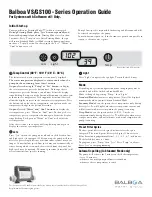
23
The time between cleaning will vary from weeks to months depending
upon water conditions and usage.
The depth of lime buildup should be measured periodically. Heaters
equipped with cleanouts will have about 2” of lime buildup when
the level of lime has reached the bottom of the cleanout opening. A
schedule for deliming should then be set up,based on the amount
of time it would take for a 1” buildup of lime. It is recommended that
the water heater initially be inspected after 6 months.
Example 1:
Initial inspection after 6 months shows 1/2” of lime accumulation.
Therefore, the heater should be delimed once a year.
Example 2:
Initial inspection after 6 months shows 2” of lime accumulation.
Therefore, the heater should be delimed every 3 months.
FIGURE 22.
DELIMING SOLVENTS
Hydrochloric base acids are not recommended for use on glass lined
tanks. Observe handling instructions on label of product being used.
TANK CLEANOUT PROCEDURE
The following practices will ensure longer life and enable the unit to
operate at its designed efficiency:
1. Once a month the heater should be flushed. Open the drain valve
and allow two gallons of water to drain from the heater. Inlet water
valve should remain open to maintain pressure in tank.
2. A cleanout opening is provided for periodic cleaning of the tank.
Gas must be shut off and heater drained before opening cleanout.
To clean heater through cleanout opening, proceed as follows:
1. Drain heater.
2. Remove outer cover plate from lower side of heater jacket.
3. Remove six (6) hex head screws securing tank cleanout plate
and remove plate.
4. Remove lime, scale, or sediment using care not to damage the
glass lining.
5. Inspect cleanout plate gasket, if new gasket is required, see
replacement parts list for item number.
6. Install cleanout plate. Be sure to draw plate up tight by tightening
screws securely.
7. Replace outer jacket cover plate.
8. In some water areas the sediment might not be removed by this
method and may result in the water heater making rumbling or
boiling noises.
DRAINING AND FLUSHING
It is recommended that the water heater storage tank be drained
and flushed every 6 months to reduce sediment buildup. The
water heater should be drained if being shut down during freezing
temperatures. See Installation Considerations in this manual for
the location of the water heater components described below.
Burn harzard.
Hot water discharge.
Keep hands clear of drain
valve discharge.
TO DRAIN THE WATER HEATER STORAGE TANK:
1.
Turn off gas supply at the Main Gas Shutoff Valve if the water
heater is going to be shut down for an extended period.
2. Ensure the cold water inlet valve is open.
3.
Open a nearby hot water faucet and let the water run until the
water is no longer hot.
4. Close the cold water inlet valve to the water heater.
5. Connect a hose to the water heater drain valve and terminate
it to an adequate drain.
6. Open the water heater drain valve and allow all the water to
drain from the storage tank.
7. Close the water heater drain valve when all water in the
storage tank has drained.
8.
Close the hot water faucet opened in Step 4.
9.
If the water heater is going to be shut down for an extended
period, the drain valve should be left open.
TO FLUSH THE WATER HEATER STORAGE TANK:
1. Ensure the cold water inlet valve is open.
2.
Open a nearby hot water faucet and let the water run until the
water is no longer hot. Then close the hot water faucet.
3. Connect a hose to the drain valve and terminate it to an
adequate drain.
4.
Ensure the drain hose is secured before and during the entire
flushing procedure. Flushing is performed with system water
pressure applied to the water heater.
5.
Open the water heater drain valve to flush the storage tank.
6.
Flush the water heater storage tank to remove sediment and
allow the water to flow until it runs clean.
7.
Close the water heater drain valve when flushing is completed.
8. Remove the drain hose.
9.
Fill water heater. See Filling The Water Heater in this manual.
10.
Turn on gas supply to water heater at Main Gas Shutoff Valve.
11.
Allow the water heater to complete several heating cycles to
ensure it is operating properly.
SERVICE
Before calling for repair service, read the “Start Up Conditions”
and “Operational Conditions” found in the “For Your Information”
section of this manual.
If a condition persists or you are uncertain about the operation
of the water heater contact a service technician. If you are not
thoroughly familiar with gas codes, your water heater, and safety
practices, contact your gas supplier or qualified installer to check
the water heater.
Use the ”Leakage Checkpoints” guide to check a “Leaking”
water heater. Many suspected “Leakers” are not leaking tanks.
Often the source of the water can be found and corrected.
Read this manual first. Then before checking the water heater make
sure the gas supply has been turned “OFF”, and never turn the gas
“ON” before the tank is completely full of water.
Never use this water heater unless it is completely filled with water.
To prevent damage to the tank, the tank must be filled with water.
Water must flow from the hot water faucet before turning “ON” gas
to the water heater.
Summary of Contents for CLN 075100
Page 4: ...4 GENERAL SAFETY INFORMATION...
Page 32: ...32 NOTES...
Page 33: ...33 NOTES...
Page 34: ...34 NOTES...














































